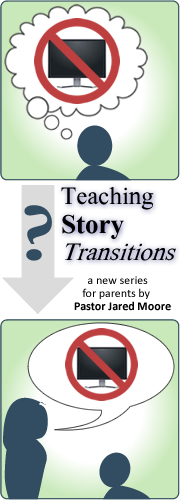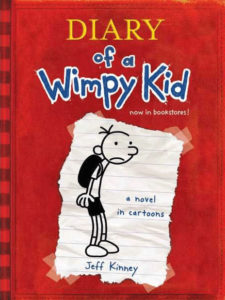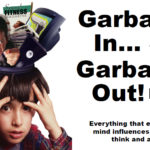Teaching Story Transitions 5: Middle-Grade Exploration
(Real-life parenting and other tasks can sideline other efforts, as was the case for this series begun last year. Two other featured series, Speculative Politics and the first Speculative Faith Reading Group: The Hobbit installments, occupied the break. Now Politics is over, and we’ve caught up to The Hobbit book where the first film ended. We now return you to your irregularly scheduled program featuring Pastor Jared Moore: Teaching Story Transitions.)
 Christian books, family manuals, and other materials jump directly from the “children, be sheltered” stage to “parents, shelter your children” — with little discussion of what comes between. That’s why parents must plan how they will teach their children’s transitions.
Christian books, family manuals, and other materials jump directly from the “children, be sheltered” stage to “parents, shelter your children” — with little discussion of what comes between. That’s why parents must plan how they will teach their children’s transitions.
First we must recognize un-Biblical story discernment. Second, we learn to practice our own discernment — not treating children as innocents corrupted by the world, but sinners who need Christ. Third, we begin not with seemingly practical motives to discern, but with knowing and loving God’s Story. And fourth, we may choose to apply this to teaching our children by using what’s known in classic-education circles as the “trivium” method.
Per the Trivium, a first teaching stage involves mainly teaching children how to use truth-discernment tools. This is the introduction process. As you guide them to some stories and away from others, you begin to train them to do the same for themselves. What do they think about what they see? More vitally, based on God’s Word, what does He think of it?
Then comes the Trivium’s second stage, into which parents and teachers gradually phase:
2. Middle-grade exploration: Challenge children to discern more on their own.
In classical education this is called the “logic stage.” It starts at about the fifth grade and phases out in eight grade. Here, one teaches children to begin thinking more analytically.
Quite naturally children at this age have already begun growing beyond memorizing all the tools of learning (tools taught through catechesis: memorizing the Bible, understanding how Scripture answers man’s basic worldview questions, and so on). Now they are starting to think through the “why” questions behind all arguments. We assume this growth of the human brain is God-designed because He created all things and holds all things together (Gen. 1:1; John 1:1-4; Col. 1:16-17). Thus we need to capitalize on this development by helping children think through the truth-claims they hear in any stories they encounter.
Our goal is to help children start discerning specific worldviews being presented in media. Remember the worldview questions we asked earlier in part 3:
- Creation: How did it all begin? Where did we come from?
- Fall: What went wrong? What is the source of evil and suffering?
- Redemption: What can we do about it? How can the world be set right again?
Remember also how Christians answer these questions based on Scripture:
- Creation: The only God who exists created all things, including you, for His own glory (Gen. 1; especially Gen. 1:26; Col. 1:16-17).
- Fall: Adam and Eve sinned against God, and all creation including humanity fell into sin (Gen. 3; Rom. 3:10-23; Rom. 8:20-22). Thus, all humans are sinners, which means that we are what is wrong with the world (Rom. 3:23; Gal. 3:22).
- Redemption: God the Son incarnate, Jesus Christ, came to earth to fix what Adam messed up. Jesus Christ — through His life, death, and resurrection — is the only answer for the sin problem (Rom. 8:1-39; John 14:6).
In light of these Scriptural truths, parents need to guide their children to understand how media and stories answers these worldview questions with their own “truth-claims.” Then parents teach their children how to correct the wrong answers with Scripture.
 For example, let’s take a brief look at one popular franchise of stories, in this case stories specifically geared for child readers: the Diary of a Wimpy Kid series. My wife, children, and I have enjoyed these books (and film adaptations) about “wimpy kid” Greg Heffley, whose comical struggles are endearing to anyone who has endured the horror of middle school.
For example, let’s take a brief look at one popular franchise of stories, in this case stories specifically geared for child readers: the Diary of a Wimpy Kid series. My wife, children, and I have enjoyed these books (and film adaptations) about “wimpy kid” Greg Heffley, whose comical struggles are endearing to anyone who has endured the horror of middle school.
See if your children can recognize the stories’ worldview. Ask them how the series answers these questions:
- Why does man exist?
- What’s wrong with the world?
- How is the problem fixed?
Does Diary of a Wimpy Kid argue that man exists for God’s glory? Do the stories show that sin is what’s wrong with the world — that sinful humanity is part of what’s wrong with the world? Do they argue that Jesus is the only cure for the sin disease? If not, what do they say? What claims can we accept because they align with Scripture? What must we reject?
Parents and teachers must also encourage children to recognize immorality in stories, and know the reasons why immorality is in this series. Of course, the prime reason is sin; sin taints everything. Put another way, the characters refuse to love God with all their hearts, souls, and minds, and to love their neighbors as themselves (Matt. 22:37-39). Why? Because their hearts are wicked and selfish, in rebellion against God. They do not care about the things of God. That’s the real problem. What’s the solution? They need Jesus!
Of course this series doesn’t present sin as the problem or Christ as the cure. Diary goes askew by not correctly diagnosing our disease. Though some stories more closely align with Biblical truth about either — even without direct allusions to the Gospel — Diary of a Wimpy Kid argues the main character’s problems include, “I’m not having my best life now,” or “I’m not cool,” or “My brother is mean to me.” These are understandable. But they’re not our main problems in reality. They’re symptoms of our greatest problem: ourselves.
So what’s the solution? Even if you do “fix” such problems, you won’t live happily ever after because sin infects all creation and all human relationships. Children must face reality: even if people think you’re cool and your brother stops being mean to you, you’ll still die one day and stand before your Creator, and He won’t be impressed. To hell you will go!
That’s the negative side of challenging children to discern. But we must not end there, for if we do we would miss all the ways stories reflect the truth about God, people, and creation. So we must teach children to find these “fingerprints” — after all, all truth is God’s truth and all lies are Satan’s lies. The Diary of a Wimpy Kid series encourages us toward humility, to laugh at ourselves. It values the traditional family. It doesn’t exalt rampant immorality. It says sin has consequences (though it doesn’t call it sin). It recognizes God’s fingerprints in people (we are His image-bearers). It encourages children to love their parents, brothers, friends, and neighbors. It values human life. It rejects superficiality. The list goes on.
What else may we find? You and your children in this learning stage can find out together as you evaluate the truth claims of stories you encourage them to enjoy. Of course, that can only happen if you are personally involved with media and stories yourself — still hands-on, still guiding your children and practicing your own discernment to avoid material that isn’t beautiful, good, or truthful. But what about the time when your children will finally begin taking the reins of their own discernment? We’ll discuss that last phase in part 6.









































I like the valuable info you supply on your articles. I will bookmark your blog and test again right here frequently. I’m moderately certain I’ll be told many new stuff proper here! Best of luck for the next!